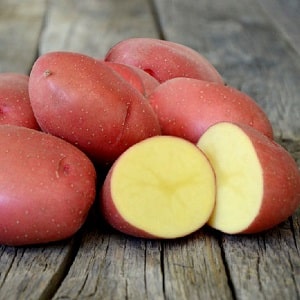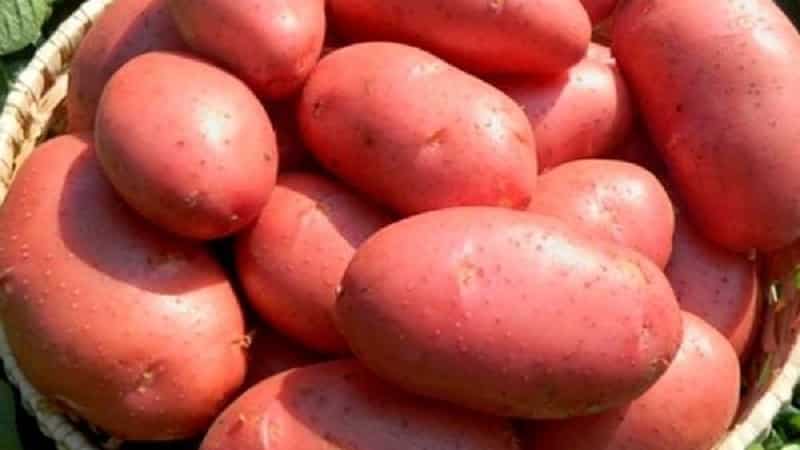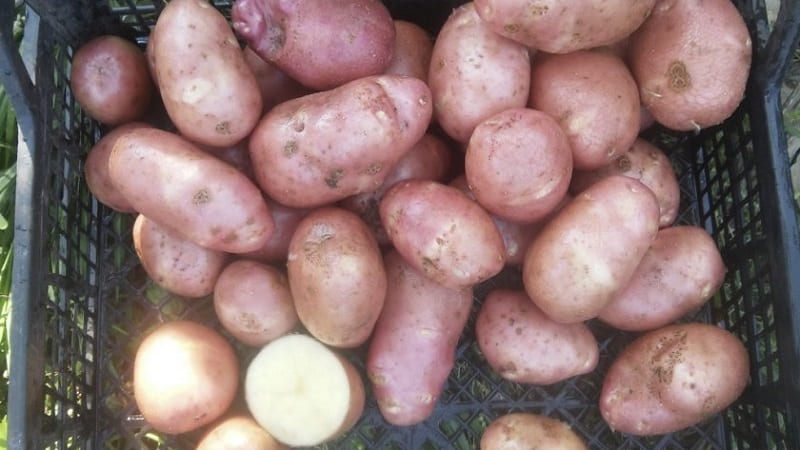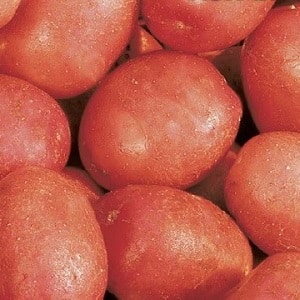Potato variety "Krasa" with excellent presentation and excellent taste
Krasa potatoes enjoy deserved popularity among lovers of their own vegetables due to their high adaptability to climatic conditions and the absence of difficulties in care.
In the article we will look at the characteristics of the variety, the features of agricultural technology and find out what gardeners and summer residents think about the Krasa potato.
Description of potato variety
Mid-early table variety, characterized by stable yield, productivity and excellent taste. Known as a variety with good keeping quality and transportability.
Origin and development
Appeared as a result of the work of the best European breeders. Registered in the Russian State Register of Selection Achievements in 2017.
Recommended for cultivation in the Central region, but is successfully cultivated throughout the Russian Federation.

Distinctive features, appearance
With proper care, potatoes grow oval in shape, weighing 300-400 g. Tubers with small, deep eyes, light yellow flesh. The peel is dense, smooth, from light pink to crimson-red in color. The starch content in tubers is 15-19%, which indicates the suitability of potatoes for baking, boiling, stewing and frying. Resistant to pathogenic microflora, mechanical damage, drought.
Distinctive features:
- the ability to grow in all regions of Russia with different weather conditions;
- crop stability;
- during heat treatment, the tubers do not change color and do not crumble;
- contains vitamin C;
- It is grown by two methods - seed and tuber.
Description and characteristics of the plant
The bushes are erect, strong, moderately spreading, with a dense stem. The stem is powerful. The application of nitrogen fertilizers leads to the development of even more powerful shoots, reaching 70 cm in height. The corollas are medium-sized with red-violet inflorescences. The leaves are formed one opposite the other, with 3-7 lateral lobes, the color is rich green. Multi-seeded fruits resemble small, unripe tomatoes. One bush is capable of producing 6-8 tubers.
The harvest is 400-450 centners per hectare, it is collected 80-100 days after planting. Yield indicators are influenced by climatic conditions, proper care and growing conditions.

How to grow this variety
Potatoes are planted in the usual way or with seeds using conventional agrotechnical practices.
Important! Planting potatoes with seeds helps renew the planting material and produce vegetables without pathogenic properties.
When planting seeds, take into account the features:
 to increase the percentage of germination, before planting in the ground, the seeds are soaked for several days in a damp cloth;
to increase the percentage of germination, before planting in the ground, the seeds are soaked for several days in a damp cloth;- then the seeds are hardened by placing them in the refrigerator at a temperature of +1°C for 12 hours, then left at room temperature for another 12 hours;
- planted 80 days before planting in the garden;
- for planting seed material, select highly fertile loose soil, preferably on the sunny side of the site;
- the seeds are laid out on the surface of the soil without being buried;
- cover the bed with the sown seeds and leave for 1-2 weeks until the seeds germinate;
- Periodically, the seeds are watered from a small watering can.
Other potato varieties:
Medium-early, unpretentious potato "Red Fantasy"
Dates, scheme and rules of planting
Planting times depend on the planting method. If the material is prepared in advance, the seeds are sown in late March - early April. Tubers are sent into the ground from late April to mid-May.
With the tuber method the material is placed in a bright, warm place for germination 1-1.5 weeks before planting. During the germination process, tubers with weak, black sprouts are selected - they are unsuitable for planting. Immediately before planting in the ground, the tubers are treated with a fungicide solution for additional protection against diseases and pests.
At the time of planting, make sure that the threat of night frosts has passed. Daytime temperature should be 15°C, night temperature +4°C. The optimal temperature of soil heated to a depth of 50 cm is +7...+10°C.
Holes are dug at a distance of 35-40 cm deep by one bayonet of a shovel, humus is placed on the bottom and 1 liter of warm water is poured in. The tubers are placed in the holes with the sprouts facing down. The distance between rows is 60-70 cm.

Care
When the root system is being laid, the garden is not watered. Later, watering is carried out regularly between the rows, increasing at the time of flowering and stopping before harvesting.
In between waterings to improve air exchange and formation For large, high-quality tubers, the soil is loosened and weeded. Do not allow the bed to become overgrown with weeds, since with a more developed root system and high growth vigor they are able to choke out the potato bushes, taking nutrients and moisture for themselves.
Hilling or mulching is carried out several times during the growing season.. Hilling is the formation of high ridges of earth around each potato bush. Mulching is covering the soil around the bushes with a layer of grass, sawdust, and straw. Mulching makes it possible to do without weeding and hilling and maintains the level of moisture in the soil.
Nuances of cultivation and possible difficulties, diseases and pests
 Specialists It is recommended to plant potatoes in the garden where they were grown cucumbers, legumes, onions, pumpkin, radishes, lettuce. Every 3-4 years the planting site is changed. Potatoes of the Krasa variety are best planted in the southern, south-eastern parts of the site, with shrubs located on the northern and north-western sides that protect from the wind.
Specialists It is recommended to plant potatoes in the garden where they were grown cucumbers, legumes, onions, pumpkin, radishes, lettuce. Every 3-4 years the planting site is changed. Potatoes of the Krasa variety are best planted in the southern, south-eastern parts of the site, with shrubs located on the northern and north-western sides that protect from the wind.
Potatoes should not be planted in holes or other depressions., since excess moisture leads to putrefactive processes. The soil chosen is well aerated, with sufficient oxygen content. Krasa loves abundant watering and responds to it with a high yield.
Feeding is carried out several times per seasonusing mineral and organic fertilizers:
- chicken manure is diluted with water in a ratio of 1:15 and placed in a warm place for 2-3 days, watered 1 liter per bush;
- ash - up to 10 kg per hundred square meters;
- urea or ammonium nitrate;
- ammophoska.
The variety is known for its resistance to most known diseases at the genetic level, therefore preventive work is rarely carried out. However, if seed material was used of inadequate quality and crop rotation conditions were not observed, the likelihood of diseases increases.
Apply:
- from scab - “Maxim or “Ditan”;
- for late blight - “Ridomil” or “Agate”;
- for Alternaria - 1% Bordeaux mixture, a course of 4 times a week.
Rarely attacked by pests, if this does happen, bushes are treated with insecticides or fungicides:
- from the Colorado potato beetle - “Iskra”, “Aktara”;
- from caterpillars - “Danadim”, “Zolon”;
- from mole crickets - “Medvetox”, “Medvetsid”.

Collection, storage and use of crops
Krasa potatoes are harvested using the standard method 80-100 days after planting. Dig potatoes in dry, warm weather, so the vegetable will last longer.
After harvesting, the crop is sorted: spoiled, rotten fruits are thrown away, some of suitable size and good quality are set aside as planting material for the next year, the rest is left for consumption
Important! For better preservation, the tubers are sprayed with a weak solution of copper sulfate, placed in wooden boxes and stored in a moderately humid basement.
Krasa is stored at a temperature of +2...+4°C for a fairly long period of time - until spring. At higher temperatures, tubers begin to germinate and lose their quality.
Read also:
Advantages and disadvantages of the variety
The Krasa potato variety was created with improved qualities. The successful result of cultivation is confirmed by the inclusion of the variety in the State Register of Breeding Achievements.
Gardeners and agronomists note the absence of deficiencies in this variety. If the rules of cultivation and care are followed, the harvest corresponds to what is stated in the register.
Advantages:
 high weight of ripened tubers;
high weight of ripened tubers;- stable harvest;
- high keeping quality;
- excellent taste;
- resistance to mechanical damage and diseases;
- preservation of presentation;
- resistance of the bush to lodging.
For which regions is it best suited?
Potato variety Krasa suitable for cultivation in all regions of the CIS countries. Depending on the place of cultivation, the timing of planting and the amount of watering differ.
The preferred region for growing the variety is Central. In the Moscow region, where the level of moisture in the soil is relatively high, it can be difficult to grow Krasa, so planting is done on a hill, the soil is loosened more often to ensure access of oxygen to the tubers.
The average ripening period allows cultivation in the northern regions, however, to preserve the harvest, potato beds are covered with film or agrofibre so that possible frosts do not damage the bushes.
Farmer reviews
Gardeners and housewives highly appreciate the quality of Kras potatoes and recommend them for planting in their plots.
 Gennady, Torzhok: “I first planted Krasu in my garden two years ago. I got large, tasty tubers in the fall. I'm pleased with the result. I plan to double the number of landings".
Gennady, Torzhok: “I first planted Krasu in my garden two years ago. I got large, tasty tubers in the fall. I'm pleased with the result. I plan to double the number of landings".
Galina, Pudozh: “I’ve been looking for a long time for a variety that doesn’t get soggy when cooked. Having tried the Krasa variety, I settled on it. I like the smooth skin and pink flesh, as in the photo on the Internet. You can either fry it or cook it in its jacket. It can be stored for a long time until the next harvest.".
Nikolay, Volkhov: “I learned about the method of growing potatoes from seeds. At first I didn’t believe it, but I decided to check it on Kras. For comparison, I planted some with tubers and some with seeds. The result was surprising: potatoes grown from seeds looked no different from those grown in another way, and by the next spring they were better preserved. Now, once every three years, I update the planting material in this way if I notice the tubers getting smaller.”.
Conclusion
The new potato variety Krasa is another success in plant breeding.The variety is unpretentious in care, adapts well to adverse weather conditions, and has stable immunity. It is endowed with excellent taste and produces consistently high yields. The ability to grow in all regions makes it attractive to many gardeners.